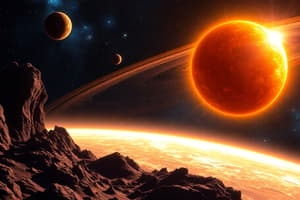Podcast
Questions and Answers
When did most objects in the solar system form?
When did most objects in the solar system form?
- 1 million years ago
- 2 billion years ago
- 4.5 billion years ago (correct)
- 10,000 years ago
What is the central part of the enormous cloud of gas and dust that formed the solar system?
What is the central part of the enormous cloud of gas and dust that formed the solar system?
- Moons
- Asteroids
- Comets
- The Sun (correct)
How have scientists gained more knowledge about the solar system in the past 50 years?
How have scientists gained more knowledge about the solar system in the past 50 years?
- By studying ancient texts
- By conducting experiments in a lab
- By using powerful new telescopes (correct)
- By exploring deep sea creatures
Which branch of science allows for vicarious travel to study objects in the solar system?
Which branch of science allows for vicarious travel to study objects in the solar system?
What have spacecraft like Voyager, Pioneer, Curiosity, and Pathfinder done in relation to the planets?
What have spacecraft like Voyager, Pioneer, Curiosity, and Pathfinder done in relation to the planets?
Apart from planets and moons, what other interesting objects have been investigated in our solar system?
Apart from planets and moons, what other interesting objects have been investigated in our solar system?
Which objects make up the solar system besides the Sun and the planets?
Which objects make up the solar system besides the Sun and the planets?
How long ago did most objects in the solar system form?
How long ago did most objects in the solar system form?
What did the spacecraft Voyager, Pioneer, Curiosity, and Pathfinder do in relation to the planets?
What did the spacecraft Voyager, Pioneer, Curiosity, and Pathfinder do in relation to the planets?
What are some of the objects that have been explored by spacecraft in our solar system?
What are some of the objects that have been explored by spacecraft in our solar system?
Where did most of the material in the outer parts of the enormous cloud end up forming?
Where did most of the material in the outer parts of the enormous cloud end up forming?
What branch of science allows for vicarious travel to study objects in the solar system?
What branch of science allows for vicarious travel to study objects in the solar system?
Flashcards are hidden until you start studying
Study Notes
- The solar system consists of the Sun, planets, moons, rings, asteroids, comets, and dust, all formed about 4.5 billion years ago from a cloud of gas and dust.
- Decades of observation and spacecraft exploration have provided a wealth of information about the solar system.
- Spacecraft missions like Voyager, Pioneer, Curiosity, and Pathfinder have allowed for close-up study of planets, moons, asteroids, comets, and more.
- Planetary astronomy is unique as it enables researchers to virtually travel to and study various objects in the solar system.
- The exploration of the solar system has revealed fascinating details about dwarf planets, moons, ring systems, asteroids, and comets.
Studying That Suits You
Use AI to generate personalized quizzes and flashcards to suit your learning preferences.




